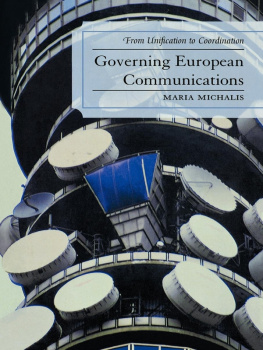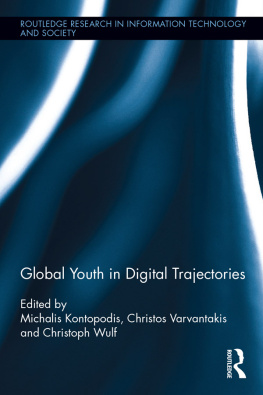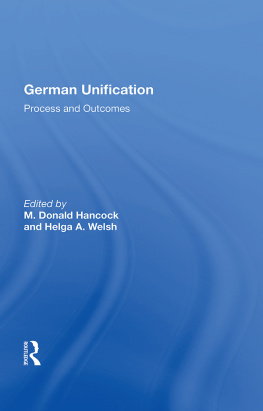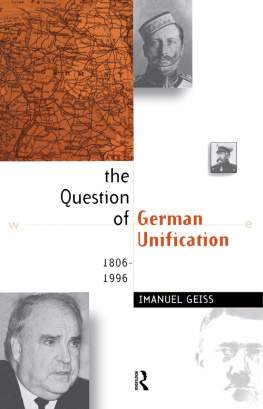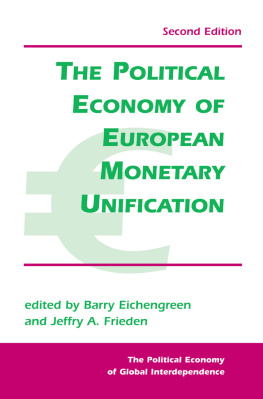Michalis - Governing European communications : from unification to coordination
Here you can read online Michalis - Governing European communications : from unification to coordination full text of the book (entire story) in english for free. Download pdf and epub, get meaning, cover and reviews about this ebook. City: Europe., year: 2007, publisher: Lexington Books, genre: Politics. Description of the work, (preface) as well as reviews are available. Best literature library LitArk.com created for fans of good reading and offers a wide selection of genres:
Romance novel
Science fiction
Adventure
Detective
Science
History
Home and family
Prose
Art
Politics
Computer
Non-fiction
Religion
Business
Children
Humor
Choose a favorite category and find really read worthwhile books. Enjoy immersion in the world of imagination, feel the emotions of the characters or learn something new for yourself, make an fascinating discovery.
Governing European communications : from unification to coordination: summary, description and annotation
We offer to read an annotation, description, summary or preface (depends on what the author of the book "Governing European communications : from unification to coordination" wrote himself). If you haven't found the necessary information about the book — write in the comments, we will try to find it.
Michalis: author's other books
Who wrote Governing European communications : from unification to coordination? Find out the surname, the name of the author of the book and a list of all author's works by series.
Governing European communications : from unification to coordination — read online for free the complete book (whole text) full work
Below is the text of the book, divided by pages. System saving the place of the last page read, allows you to conveniently read the book "Governing European communications : from unification to coordination" online for free, without having to search again every time where you left off. Put a bookmark, and you can go to the page where you finished reading at any time.
Font size:
Interval:
Bookmark:
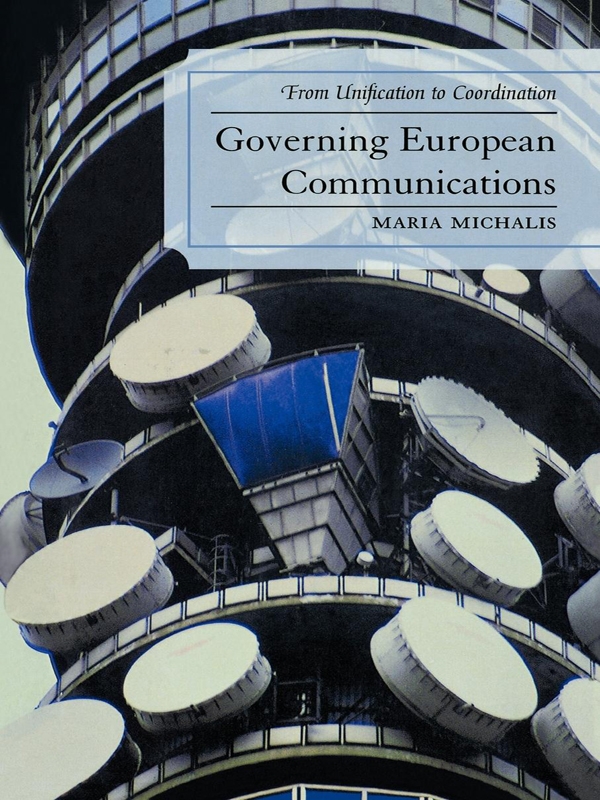
Many people have helped me with this book. To start with, I would like to thank all those who graciously gave up their time to respond to my questions and to discuss a wide range of topics, in the knowledge that without their contribution it would have perhaps been impossible to understand the complexity of the issues involved.
I would also like to thank the Communication and Media Research Institute and the Department for Journalism and Mass Communication at the University of Westminster for giving me a semesters research leave as well as my colleagues who covered for me in my absence. Special thanks to Jill Hills, my mentor and now friend, who has stood by me throughout this project.
My thanks also go to Andrew Calabrese, the series editor, for his long-distance but unfailing encouragement and to Joseph Parry, associate editor at Lexington Books, for his support and advice.
Finally, on a personal note, I would like to thank Spyros and my family for always being there for me.
Broader context
U.S. hegemony. Cold War. Conflicts over the need for and character of Western European cooperation for postwar reconstruction. Telecommunications and broadcasting under sovereign control of national monopolies and national governments.
Key actors
National governments (European and non-European). State-owned or controlled national monopolies. Council of Europe, EBU, CEPT.
Governance areas and style: Main characteristics
Intergovernmental (Council of Europe) and professional (EBU/OIRT & CEPT cooperation on cross-border commercial technical and operational issues. No challenge to established national communications order. Consensual style. Communication sectors needs often victim of broader international political and diplomatic imperatives (e.g., Cold War).
Governance instruments
Mostly non-binding recommendations.
Implementation
Voluntary. No sanctions. National governments and administrations enjoyed great latitude.
Relationship among European organizations
No direct formal links. Sectors and policy competence clearly demarcated.
Broader context
International political economic turmoil. Crisis of Keynesianism. Theoretical understandings stressing role of ICT in economic growth. Growing competitive threats from USA and later Japan in high technology, especially computing and data processing (e.g., IBM). Technological disparities and gap discourses. Telecommunications and broadcasting under sovereign control of national monopolies and national governments.
Key actors
National governments (mostly European and U.S.). Individual firms (e.g., national champions, IBM). PTTs and CEPT, Council of Europe, EBU, European Commission, European Court of Justice.
Governance areas and style: Main characteristics
Individual national interventionist industrial policies focusing on computing. Promotion of national capital (national champions). Selective intergovernmental cooperation in high technology (e.g., aerospace, space). Failed attempts at European cross-national groupings in computing. EU pursues broad policy objectives but no support from either governments or industry. Three-pronged strategy: harmonization of European technical standards and administrative rules; broad economic and industrial planning role (including science and technology, and opening up of public procurement); common network planning and standards and common network development (e.g., OSI, Euronet). Emphasis on information technology and on countering IBMs dominance. European external identity. Reactive style.
Governance instruments
National protectionist solutions (e.g., nontariff trade barriers, subsidies, managed industry restructuring). European Commission own initiatives. Competition law (European Court of Justice).
Implementation
No support for European common action. Policies are national.
Relationship among European organizations
No direct formal links. Sectors and policy competence clearly demarcated.
Broader context
Increasing internationalization and competitive threats from USA, Japan and Asian Tigers. Information society: answer to falling productivity and growth. Relaunch of Europe on the basis of the needs of European industrial capital. Neomercantilist vision of European integration. New growth and new trade theories justifying public intervention and emphasizing economies of scale. Digitalization: technological convergence of telecommunications and information technology. U.S. domestic telecommunications liberalization raises alarm in Europe. Gradual entry of private commercial and transnational broadcasters in Europe.
Key actors
European industrialists (ERT). Europe-wide interest groups (e.g., Big 12, ITTF). EU (Commission and Court). Mutually supportive relationship between parts of European Commission and established interests (PTTs/CEPT, public service broadcasters/EBU, major European ICT manufacturers, ailing national champions).
Governance areas and style: Main characteristics
Construction of Europe, inward-looking phase. European-level industrial policy measures: emphasis on big home market and economies of scale. Promotion of transnational European capital (European champions). Sponsored R&D programs (ESPRIT, RACE). Network planning (ISDN, GSM). Defensive standardization (MAC HDTV). Transfrontier television and pursuit of democratic ideals. Pan-European television experiments. European cultural unity and internal identity based on nation-state experience. Mostly reactive style.
Governance instruments
European single market: internal liberalization, active industrial policy and temporary external trade protection (Fortress Europe scenario). Emphasis on technology-push initiatives.
Implementation
Top-down measures and enforcement.
Relationship among European organizations
Mutually supportive.
Broader context
Changing international and sectoral political economy leads to progressive procompetitive restructuring of telecommunications and television markets. Main factors: limitations of Keynesian order, economic liberalization and internationalization, technological change, pressure from Europes trading partnersnotably USAbilaterally and multilaterally within GATT, dissatisfaction of big economic actors with existing monopolistic high-cost national communications order in Europe, rise of neoliberal ideology, international acceptance of trade in services. EU mediates globalizing pressures: reinforcing them in telecommunications, resisting them in audiovisual. End of Cold War. Internal market project: neomercantilist vs. neoliberal vision. Competitiveness industrial policy (against active interventionism). Renewed information society vision as the answer to Europes economic malaise in reaction to U.S. and internet-related developments and technological convergence.
Key actors
Proliberalization coalition in telecommunications: USA, GATT Uruguay Round, parts of European Commission, European Court of Justice, potential market entrants, corporate telecommunications users, procompetition PTOs and national governments. Proliberalization coalition in broadcasting: potential commercial market entrants, advertisers, big electronics manufacturers, publishing interests, content producers, procompetitive governments (European and U.S.), parts of European Commission, European Court of Justice. Industry fora (e.g., Digital Video Broadcasting group).
Font size:
Interval:
Bookmark:
Similar books «Governing European communications : from unification to coordination»
Look at similar books to Governing European communications : from unification to coordination. We have selected literature similar in name and meaning in the hope of providing readers with more options to find new, interesting, not yet read works.
Discussion, reviews of the book Governing European communications : from unification to coordination and just readers' own opinions. Leave your comments, write what you think about the work, its meaning or the main characters. Specify what exactly you liked and what you didn't like, and why you think so.

